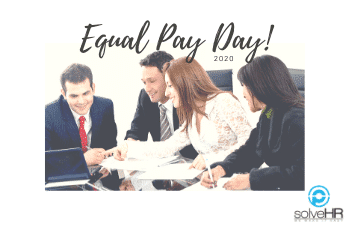- 03/31/2020
- Posted by: SolveHR-IT
- Categories: Culture & Retention, Recruitment & Selection

March 31, 2020, marks the next Equal Pay Day in the United States and is another time to evaluate your business’ pay practices to ensure that all of your employees are receiving a fair deal, regardless of their gender.
National Pay Day was created by the National Committee on Pay Equity (NCPE) in 1996 as a public awareness event that would be symbolic to how far into the year the average women must work to earn what the average man earns in the previous year regardless of experience or job type.
According to the NCPE, women on average earn less than men and must work longer for the same amount of pay, with the wage gap being even greater for most women of color.
Reviewing Pay Trends
In 1963, Congress passed the Equal Pay Act (EPA) that required employers to pay men and women equally for doing the same work—equal pay for equal work. The law was a landmark case for pay equity in the United States, but the law still has its blind spots as there are exceptions for wages determined by a merit or seniority system, a system that bases pay on the quantity or quality of work, or “a differential based on any other factor other than sex.”
In addition to the EPA, most states have their pay-equity laws. Several states and cities have banned employers from asking job candidates about their salary histories to stop pay biases in the recruiting process.
18 States have banned salary-history inquiries to various degrees, with some affecting public and private businesses. Employers who operate across different legal jurisdictions must be mindful of the local laws as they arise, as legal fees from litigations can be greater than just paying the employee a fair salary in the first place.
Measuring the Pay Gap
Measuring the gender wage gap can be difficult because when employers choose a candidate for a job, they usually figure education, years of experience, and other factors when deciding a pay offer for a potential employee. Yet, even so the data still shows that a gender pay gap does exist.
A 2019 study by Glassdoor found a roughly 5% pay difference between men and women. The American Association of University Women also concluded in another study that forms full-time workers with college degrees, women are paid 76 cents for every dollar men are paid.
These pay gaps can be caused by many factors, including the fact of women stepping out of the workforce for family obligations, women being concentrated in lower-paying “pink collar” occupations (hospitality, teaching, childcare), and plain gender bias from recruiters pitching starting salaries.
Yet those factors can’t all be used to explain away the pay gap, as its been shown that even when men enter work that is traditionally female-dominated a pay gap still exists. This can be seen in the nursing field, where a 9% pay gap has been identified.
What Can be Done
HR professionals don’t necessarily need to wait for legislation to come and force a change in how employers pay their employees fairly. Committing publicly to recruiting and promoting women is something that businesses of all sized can do, as well as making pay data more transparent to eliminate bias.
Recruiters can also undergo anti-bias training to make the hiring process as seamless as possible for job candidates, as well as utilizing up to date market data when deciding the salary range of the employee.
The first step towards compliance this Equal Pay Day is to ensure that employers understand the pay laws that apply to them. Remember readers, just because Equal Pay Day comes once a year doesn’t mean that you can’t review your business’s pay practices throughout the year. Eliminating the pay gap starts at the employer level and is reinforced by legislation, not the other way around.
Are you struggling with managing your human resource needs? SolveHR offers several transactional and strategic HR services to help your business. Contact us today to find the right solution for you, so you can focus on what matters—growing your business!
Subscribe to receive all our blogs
Written by: Matthew Muriel
Meet Matthew! Matthew is our content writer and has been working with us for a year. He enjoys working for SolveHR because it allows him to practice his copywriting and allows him to build experience in his fledgling career. Matthew studied at the University of Texas at San Antonio and earned his degree in English with a concentration in Professional Writing. He values learning new processes in the HR industry and then conveying those ideas to the company’s clients. When he isn’t working, he enjoys reading nonfiction, with his favorite book that he recently read being The Gene by Siddhartha Mukherjee. If he could go anywhere in the world he would travel across the United States and visit all of the national parks.

